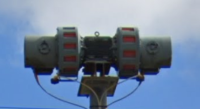Klaxon CS Series: Difference between revisions
(Add image from CDS) |
m (I Added A Trivia Fact About The CS8.) |
||
| Line 28: | Line 28: | ||
* There are currently only about 30-35 Klaxon Coded-Shutters sirens that are known to exist. | * There are currently only about 30-35 Klaxon Coded-Shutters sirens that are known to exist. | ||
* There are two CS6 sirens that are privately owned. There are no CS8 sirens that are privately owned. | * There are two CS6 sirens that are privately owned. There are no CS8 sirens that are privately owned. | ||
* Klaxon might still produce and sell CS8 Sirens, but the only proof is from a downloadable PDF. It is still highly unlikely that Klaxon Signals still produce them, though. | |||
[[Category:Sirens]] | [[Category:Sirens]] | ||
Revision as of 14:25, 18 November 2024
| Klaxon Coded-Shutters Series | |

| |
| Company | Service Electric Company Ltd. (Secomak)
Klaxon Signals, Ltd. |
|---|---|
| Produced | 1952-2005 |
| Type | Electromechanical Omnidirectional |
| Sound output | 115 dB @ 100 ft/30 m |
| Frequency | 50 Hz |
The Klaxon Coded-Shutters (CS) series was a line of sirens manufactured by British company Klaxon Signals Ltd (originally Service Electric/Sekomak). The series was introduced to the market in 1952 and regular manufacturing ceased in 2005. The sirens were designed after Klaxon's General-Purpose (GP) siren series.
History
The Service Electric Company Ltd. was founded in 1930 to manufacture industrial heating fans and blowers intended for commercial use. In the 1940s during WWII, Service Electric (who then began calling themselves Secomak) began manufacturing air raid sirens to assist the civil defense effort. After the war, in the early 1950s, Secomak began eyeing other possibly hazardous locations that may be in need of warning - specifically, chemical plants and refineries. Secomak began working on a new product, which was officially released in 1952 as the Secomak CS8. Additionally, later on, Secomak also released a single-tone variant which they called the Secomak CS6. The CS8 was retained when Secomak became Klaxon Signals, and Klaxon would produce the series until 2005 when it was discontinued.
Design
Taking the Secomak GP8, Secomak would attach a box to a hollow tube. The hollow tube would be an extension from a stator's intake. The box would contain a solenoid that was connected to a flap (now known as a 'shutter') that would be situated inside the tube. When the flap was opened, air would be allowed into the rotors, and out through the ports of the stators. When the flap was closed, air would be blocked from entering, and the sound level from the corresponding rotor would be drastically reduced. This allowed for at least two new signals, that being the 'Hi-Lo' signal, and the 'Pulse' signal.
Later on, Secomak would also introduce heaters for their sirens that would run around the stators and rotors and was connected to a thermometer, usually a box on a pole or stand beside the siren.
1st Generation (Secomak Era)
The first generation of the Coded-Shutters sirens lasted between 1952 to 1968. The most notable detail was that the first generation's motor was made by Crompton Parkinsons, a company that was based out of Leeds. The plate connecting the stators to the motor was flat.
2nd Generation
The second generation lasted from 1968-1991. The second generation was created due to Crompton Parkinsons merging with Brook Motors in the late 1960s to the early 1970s. Most second generation CS8s are equipped with motor junction boxes that connect power through the side of the box instead of underneath the box.
3rd Generation (Klaxon Era)
The third generation lasted between 1991-2005, and had a Brook Hansen motor until 2001, when the Hansen side was split from Brook Crompton motors. During the early third generation, the stator-motor plate had fans connecting the housing for the rod between the stators, which is most obvious with the Carstairs Hospital sirens.
In April 2005, Klaxon Signals decided to cease production of the Coded-Shutters series, seemingly due to a lack of sales from such series.
Trivia
- It is thought that the Coded-Shutters series had a CS10 and CS12 version, which would be the GP10 and GP12 with shutters. Although these sirens did appear on Klaxon Signals' official website, there are no known instances of either.
- The nuclear fallout tone in the United Kingdom was the Hi-Lo signal, which may suggest that more CS6's and CS8's were installed in actual civil defense systems.
- The only Coded-Shutters siren located outside of the United Kingdom is a Klaxon CS8 in the Netherlands at a fire station. Its specific whereabouts are unknown.
- There are currently only about 30-35 Klaxon Coded-Shutters sirens that are known to exist.
- There are two CS6 sirens that are privately owned. There are no CS8 sirens that are privately owned.
- Klaxon might still produce and sell CS8 Sirens, but the only proof is from a downloadable PDF. It is still highly unlikely that Klaxon Signals still produce them, though.